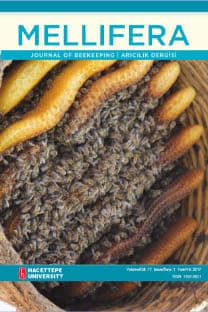Türkiye'nin farklı bölgelerine ait bal örneklerinin kimyasal ve palinolojik özellikleri
Bu çalışmada, Bursa marketlerinde satılan ve Türkiye'nin farklı bölgelerine ait 49 bal örneğinin kimyasal ve palinolojik analizleri yapılmıştır. Bal etiketlerinden elde ettiğimiz bilgilere göre bal örnekleri; İç Anadolu Bölgesi, İç ve Doğu Anadolu Bölgesi, Doğu Anadolu Bölgesi, Marmara Bölgesi, Ege Bölgesi, Akdeniz Bölgesi ve "yöresi bilinmeyenler" olarak gruplandırılmıştır. Bal örneklerinde nem, kül, invert şeker içeriği, sukroz, asidite, HMF ve diastaz aktivitesi araştırılmıştır. İncelenen bal örneklerinin kimyasal analizlerini değerlendirdiğimizde; bölgesel ortalama değerler bal örneklerinin kaliteli olduğunu gösterirken, 49 bal örneğinin 26'sı (%55) incelenen kriterler bakımından düşük kaliteli bulunmuştur. Bal örneklerinin palinolojik analizlerini değerlendirdiğimizde; Castanea sativa, Helianthus annuus, Onobrychis sp., Rubus sp., Brassica sp., Salix sp., Achillea sp., Lotus sp., Brassicaceae, Ericaceae, Euphorbiaceae, Lamiaceae, Umbelliferae, Chenopodiaceae, Centaurea sp. polenleri dominant bulunmuştur. Palinolojik analiz sonuçları ve bu konuda yapılan diğer çalışmaları incelediğimizde, Marmara Bölgesi etiketli balların bu bölgeye ait olduğu, diğer bal örneklerinin ise karışık olduğu tespit edilmiştir.
Physicochemical and palynological analysis of honey samples belonging to different regions of Turkey
In this research, 49 honey samples from different regions of Turkey being sold in Bursa markets were analyzed chemically and palynologically. According to information from the labels, we classified the honey samples as Central Anatolian Region, East Anatolian Region, Central and East Anatolian Region, Marmara Region, Mediterranean Region, Aegean Region, and "unknown Region". We researched honey samples according to moisture ratio, ash, invert sugar content, sucrose content, acidity, HMF, and diastase activity. When we evaluated the chemical analysis of the honey samples, we found that the regional average values were of good quality; however, 26 of the honey samples (55%) were of poor quality according to the criteria. When we evaluated the palynological analysis of these honey samples; Castanea sativa, Helianthus annuus, Onobrychis sp., Rubus sp., Brassica sp., Salix sp., Achillea sp., Lotus sp., Brassicaceae, Ericaceae, Euphorbiaceae, Lamiaceae, Umbelliferae, Chenopodiaceae Centaurea sp. pollens were dominant. In addition to these palynological results and in other researches, we found that the labeled honeys of the Marmara Region came from this region, whereas other regional honey samples were mixed.
___
- 1. Dalgıç, R., Manisa ve Balıkesir yöresi ballarının palinokimyasal özellikleri, XILUlusal Biyoloji Kongresi, Edirne-Türkiye.s76., 1996.
- 2. Gemici, Y., İzmir yöresi ballarında polen analizi, Doğa-Tr.J. of Botany, 15:291-296,1991.
- 3. Göçmen, M., Gökçeoğlu, M., Bursa yöresi ballarında polen analizi Doğa-TrJ.of Botany, 16:373-381,1992.
- 4. Silici, S., Akdeniz yöresi ballarında polen analizi, Y. Lisans Tezi, Akdeniz Üniversitesi, Fen Bilimleri Enstitüsü, Antalya, 1995.
- 5. Sorkun, K., Yuluğ, N., Rize-İkizdere yöresi ballarının polen analizi ve antimikrobik özellikleri, Doğa Bilim Dergisi, A2,9(l):118-123, 1985
- 6. Kaplan, A., Konya yöresi ballarında polen analizi, Y. Lisans Tezi, Ankara Üniversitesi, Fen Bilimleri Enstitüsü, Ankara, 1993.
- 7. Gür, N., Dığrak, M., Çobanoğlu, D., Elazığ yöresi ballarının polen analizi, XII. Ulusal Biyoloji Kongresi, Edirne-Türkiye, 53,1994
- 8. AO AC, In Official Methods of Analysis ( 15 tf ed.) K. Helrich (Ed.) Arlington,VA.USA: Association of Official Analytical Chemists., 1990.
- 9. Bogdanov, S., Martin, P., Lüllmann, C, Harmonised methods of the European honey commission, Apidologie, 1-59, 1997a.
- 10. Louveaux, J., Maurizio, A., Vorwohl, G., International Commission for bee botany of IUBS, Methods of Melissopalynology, Bee World, 59:139-157,1978
- 11. Erdtman, G., Handbook of Palynology, Hafner Publishing Co. New York, pp:486, 1969.
- 12. Kapp, R.O., Pollen and spores, WM.C. Brown Company Publishers, USA, pp:250, 1969.
- 13. Shauer, T., Pflanzen Europas, BVL Verlagsgeselschaft München, pp:336, 1974.
- 14. Stefanını, R., Diagnosis of unifloral honeys, II. Numerical taxonomy of honey and statistical diagnostic test of its botanical origin, Apicoltura. 4: 13-26, 1998.
- 15. Vorwohl, G., Salem, M.S.,Nour, M.E., Chemical and physical properties of Egyptian honeys, Proc. 4 Int. Conf. Apic. Trop. Climates, Cairo., 240-244, 1998.
- 16. Persano Oddo, L., Piazza, M.G., Sabatini, A.G., Accorti, M., Characterisation of unifloral honeys, Apidologie, 26: 453-465,1995.
- 17. Persano Oddo, L., Piazza, M., Pulcini, P., The invertase activity of honey, Apidologie 30:57-66, 1999.
- 18. Papoff, CM., Campus, R.L., Cicu, M.F.I., Farris, G.A., Floris, I., Rıccıardelli D'Albore G., Caratteristiche fisico-chimiche, microbiologiche e palinologiche di mieli della Somalia, Apicoltura, 4:147-172, 1988.
- 19. Piazza, M.G., Accorti M., Persano Oddo L., Electrical conductivity, ash, colour, and spesific rotatory power in Italian unifloral honeys, Apicoltura, 7: 51-63,1991.
- 20. Bosi, G., Battaglini, M., Gas chromatographic analysis of free and protein amino acids in some unifloral honeys, J. Apicult. Res., 17:152-166, 1978.
- 21. White, J.WJR., Riethof, M.L., Subers, M.H., Kushnir, I., Composition of American honeys, Tech.Bull.U.S. DepAgric, 1261:124, 1962.
- 22. White, J.WJR., Honey, The hive and Honey bee (7th ed.) Dadant and Sons, Hamilton, IL. USA, 869-918, 1992.
- 23. Ravn, V., Hammer, B., Bartels, H., En sukkerkemisk og pollenanalytisk undersgelse af nogle danske honnigtyper, Tiddskr.PlAvl. 79(1): 13-16,1975.
- 24. Codex Alimentarius Standard for Honey, Ref.Nr.CL 1993/14- SH FAO and WHO, Rome, 1993.
- 25. Bogdanov, S., Honey Quality and International Regulatory Standards: Review of the work of the International Honey Commission, Mitt. Gebiete Lebensm. Hyg., 90: 108-125, 1997.
- 26. Anon, Codex Alimetarius kommision von FAO und WHO empgihlener Europaischer regional standard fiir Honig, CAC/RS 12-1969,CV-10,p.l-17, Behris Verlag, Hamburg, Deutschland, 1991.
- 27. Crane, E., Honey: A compherensive survey, Heinernatin, London: International Bee Research Association, 1975.
- 28. Marletto, F., Ferrazzi, P., Patetta, A., Manino, A., Caratterizzaione dei mieli, Ind. Aliment.,16(3):lll-115, 1977.
- 29. Huidobro, J.F., Santana, F.J., Sanchez, M.P., Sancho, M.T., Muniategui, S., Simal-Lozano, J., Diastase, invertase and beta-glucosidase activities in fresh honey from Northwest Spain, Journal of Apicultural Research, 34(l):39-44, 1995.
- 30. Oddo, P., Baldi, E., Accorti, M., Diastatic activity in some unifloral honeys, Apidologie, 21(l),17-24, 1990.
- ISSN: 1302-5821
- Başlangıç: 2001
- Yayıncı: Hacettepe Üniversitesi
